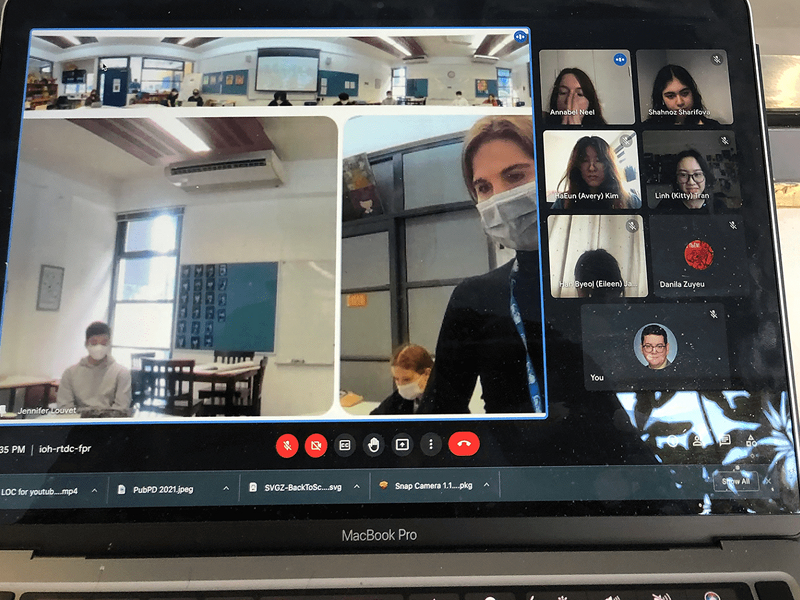
Collaboration between Tech, Faculty and Health Teams Results in Effective Hybrid Learning Solutions
Submitted by: Akofa Wallace, United Nations International School of Hanoi
Appeared on the ET Journal Spring Issue 2022
School age children living in Hanoi haven’t experienced a full day of face-to-face learning so far in the 2021-2022 academic year - a consequence of ongoing efforts by the Hanoi authorities to protect the population from Covid. In December 2021, thanks to high rates of vaccinated teenagers in Vietnam’s capital city, students starting with the most senior grades, have been slowly returning to in-person learning, but on a part time basis and with unique restrictions. As of February 2022, students in grades 7-12 have returned to campus for four hours of the day as long as they had no symptoms and did not live in a ward classified as orange or red.
“In compliance with Hanoi’s current guidance, Covid-free students living in a green or yellow ward come to campus in the mornings and then learn online in the afternoons” explains UNIS Hanoi’s Director of Technology, Adam Archer. To ensure minimal disruption to student learning, Mr Archer’s ten-member team partnered with the health centre and school leadership to develop apps and equip teachers with hardware designed to facilitate students shifting in and out of hybrid learning.
Screening Students for Covid
In an effort to find a simple way for both employees of UNIS Hanoi and families to share information about COVID-19, the School utilised its School Information System (SIS). A SIS was already being used to search data on members of the community, filter them as well as communicate with them via emails and portals. With this in mind, it made sense for the Tech Team to further utilise modules available to create ‘Covid Screening’ and ‘Opt out’ Questionnaires allowing the health centre to efficiently split students into remote or on campus cohorts based on questionnaires or household location. The cohort system provided visibility into which students were permitted on campus for accurate attendance, transportation planning and health screening which are all essential for child safeguarding.
“Thanks to the cohort system, we are able to filter students who’ve contracted Covid, are in a restricted ward or have a member in their household who has it, therefore making them ineligible to come on campus.” explained the Head School Nurse, Jo Connolly.
Ms Connolly added the cohort system has ensured the school can fulfill their contact tracing obligations as accurately as possible as it provides detailed records of students moving in and out of hybrid status.
Creating mini bubbles
A key Covid prevention strategy adopted by Vietnam from the very start of the pandemic was contact tracing. Over the past two years, the country has scaled up contact tracing efforts by introducing apps for residents to use, helping to track movements and alert people exposed to the virus. People found to be Covid positive or in proximity to someone with Covid, were required to quarantine - in some cases for two weeks. For schools, this meant that entire grades could, in theory, be required to quarantine, severely disrupting teaching and learning.
Adam Archer explained, “Recognising how easily students and teachers could end up being quarantined en masse, we sought to create an efficient way to make mini bubbles so that fewer students would be required to quarantine in the event a student tested for Covid.”
UNIS Hanoi’s Tech Team partnered with the Teaching and Learning Leads to design an app on a low code platform so that teachers can pair up students in class every week, making it easier for the School to contact trace. Tanay Naik, Secondary School Deputy Principal - Teaching and Learning said, “Our teachers have from Sunday 8am up to Monday 8am every week to log into the ‘Bubbles’ app to pair up their students within a virtual classroom space. These pairs are seated together at least two metres apart from the next pair of students, and means that if a student tests positive for the virus, we can pull up their week’s schedule and instantly identify who they were sat next to in each of their classes. Thanks to the app, our faculty and nurses can swiftly identify exposed students, with minimal disruption to teaching and learning.”
A number of iterations were made to the original design to best reflect the needs of UNIS Hanoi. For example, for classes with only ten students, pairing them up is not required. Therefore, teachers have the option to choose the “No Bubble Needed” feature.
As a result of the bubble app, UNIS Hanoi decreased the number of students and teachers having to quarantine as a result of being in close contact by up to 90% while staying compliant with local health regulations.
Camera installation to support hybrid learning
Until students are permitted to return to campus fully, the Tech Team has installed 70 cameras and tripods in physical classrooms so that students who are unable to join class in person, can still follow the class and feel included in the lesson. Tanay added, “The introduction of these cameras have reduced the need for our teachers to deliver face-to-face teaching, while making content amenable for online learning.”
Jane Mc Gee, UNIS Hanoi’s Head of School said the consistent collaboration, creativity and daily problem solving skills the Tech Team has displayed has allowed the School to keep campus open safely, while delivering both a quality face-to-face and online programme. She shared, “Our Tech Team is in a league of their own - they are simply amazing.”
About the Author
Akofa Wallace is the Communications Manager at United Nations International School of Hanoi. She can be contacted at awallace@unishanoi.org
